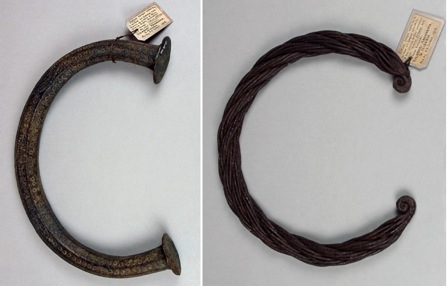Widows’ torcs
Kalabari people, Nigeria, early 20th century
 Donated by Percy Amaury Talbot in 1916; 1916.45.137 and 1916.45.141The name of these heavy metal ornaments comes form the Latin term torqueo meaning 'to twist', because of the way the metal is often twisted into shape (evident in the example on the right). Torcs made of gold or silver were worn by the ancient Celtic people of Britain as a symbol of high status, and they were later adopted by the Romans to decorate elite or distinguished soldiers during the Republican period.
Donated by Percy Amaury Talbot in 1916; 1916.45.137 and 1916.45.141The name of these heavy metal ornaments comes form the Latin term torqueo meaning 'to twist', because of the way the metal is often twisted into shape (evident in the example on the right). Torcs made of gold or silver were worn by the ancient Celtic people of Britain as a symbol of high status, and they were later adopted by the Romans to decorate elite or distinguished soldiers during the Republican period.
These torcs, one made of copper and the other of iron, were made by the Kalabari people, part of the larger Ijaw (or Ijo) group living in the Niger Delta area of Nigeria. Heavy metal jewellery – including torcs around the neck, and similar-shaped but smaller 'manilas' around the wrists and ankles – were often worn in West and Central Africa as displays of wealth. Widows wore these torcs at the funerals of chiefs and important people.
The Kalabari place great importance on the soul and the afterlife. Their funerary ceremonies focus on celebration and display, the most elaborate funerals being for the chiefs. The mourning process usually takes place over the course of months or years, punctuated by ritual events. The dress of the mourners, the decorated rooms, drumming, praise-singing and parading display represent the family's prestige, social status and aesthetic taste.
Traditionally the body was treated internally and externally with gin, salts and fragrant leaves but contemporary practice achieves preservation of the body by freezing. It is then dressed in special cloths and borne to a room decorated with the most expensive and colourfully patterned cloths the family can afford. The body is placed on a bed and accessories laid out as they would have been worn in life: hats and earrings on the pillow; bracelets, watches and rings further down the body; and canes, fans and walking sticks next to the hands. Chief female mourners traditionally wore black wraps with white blouses, although today it is common for the family to distribute white T-shirts printed with the deceased's portrait and name to mourners to wear instead. After an all-night wake, the body is taken for burial. The chief female mourners change outfit again, this time into an ensemble of velvet and striped silk and the widows put on the heavy metal manila and torc heirlooms.
For ten months, the close female relatives wear mourning dress. After this time, there is feast of food and drink and the mourners wear elements of European dress (including bowler and top hats) and speak English, to show that by this time, the chief has become so great as to dine with the white men in the ghost world. Months or years after this, the family of the chief perform a play and organise a parade of war canoes. A carved image of the chief is made and placed in the shrine among the other ancestors. The metal torcs are placed by this image until there is another funeral.
The emphasis on display in Kalabari funeral practices reinforces social positions, reunites members of extended family who contribute money and gifts, and the presence of so many female relatives signifies the renewal of the lineage through procreation.
